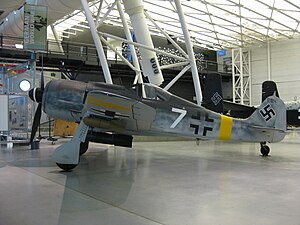

| Fighter-bomber attacks on the United Kingdom | |||||||
|---|---|---|---|---|---|---|---|
| Part of World War II | |||||||
 A fighter bomber variant of the Focke-Wulf Fw 190 on display at the Steven F. Udvar-Hazy Center in 2009 | |||||||
| |||||||
| Belligerents | |||||||
|
|
| ||||||
| Casualties and losses | |||||||
| 62 aircraft, 62 pilots[2] | Significant civilian casualties[1] | ||||||
From March 1942 until June 1943, the German Luftwaffe (air force) conducted fighter-bomber attacks on the United Kingdom. These operations typically involved a small number of Focke-Wulf Fw 190 armed with bombs. The raiders entered British airspace at a low altitude, and attacked a town or military target in southern England and then returned to their bases in occupied France. British anti-aircraft batteries and Royal Air Force fighter aircraft had difficulty stopping the German fighter-bombers, and the raids caused a significant number of casualties. While these operations were successful in tying down Allied resources at a relatively low cost to the Luftwaffe, the British Government regarded the campaign as a nuisance given the small scale of the individual raids. The fighter-bomber attacks on the UK ceased in June 1943 when the Fw 190s were transferred to the Mediterranean.
The first German fighter-bomber raids on the UK occurred during the Battle of Britain in 1940. After the Luftwaffe's specialist ground attack aircraft, the Junkers Ju 87, suffered heavy losses in attacks on Britain, it was decided to use modified Messerschmitt Bf 109s and Messerschmitt Bf 110 as fighter-bombers.[3] The first unit equipped with these aircraft, Erprobungs Grupp 210, began conducting operations against shipping in the English Channel in the third week of July. The unit began conducting operations against ground targets on 12 August, when aircraft from its three squadrons (staffel) simultaneously attacked radar stations near Dover, Pevensey, Rye and Dunkirk.[4] The unit continued conducting fighter-bomber operations throughout July, but suffered heavy losses during raids on inland targets; casualties among the Bf 110s were particularly high, and it became clear that these large and relatively slow aircraft were not suited to the fighter-bomber role.[5] Nevertheless, the Luftwaffe decided to expand its fighter bomber force, and an additional group equipped with modified Bf 109s became active in August. On 2 September Hermann Göring, the Commander-in-Chief of the Luftwaffe, directed that one squadron of each Bf 109 group was to be equipped with fighter-bombers, and that these aircraft were to be used to attack the British aircraft industry and other industrial facilities.[6]
Despite Göring's directive, only 19 fighter-bomber operations were conducted against the UK during September. These operations involved 428 sorties, of which 264 were conducted against London. Only four fighter-bombers were lost, with one being shot down by fighter aircraft and the other three falling victim to anti-aircraft guns.[7] On 26 September, a force of 50 fighter-bombers and level bombers successfully attacked the Supermarine aircraft factory at Woolston, Southampton; this raid stopped all production at the factory for a period, and killed more than 30 people. The Royal Air Force (RAF) shot down three of the raiders, but lost six fighters.[8] The next day, ten Bf 110 fighter-bombers escorted by other fighters attempted to attack either RAF Filton, or another target located near Bristol. This force was intercepted by No. 504 Squadron RAF, and the Bf 110s dropped their bombs on Bristol, causing little damage.[8]
Later in autumn, the Luftwaffe conducted a series of attacks on London made by Bf 109 fighter-bombers.[8] These operations represented the majority of German attacks on the UK in October, and the British defences had difficulty detecting and intercepting the high-flying and fast fighter-bomber formations. Due to the speed these forces traveled at, British radar stations were usually only able to provide less than 20 minutes warning before the aircraft arrived over London.[9] Overall, 140 separate attacks involving 2,633 fighter-bomber sorties were conducted against London during October. Losses were light, with 29 Bf 109s being destroyed.[10] While October marked the peak of figher-bomber operations in 1940, attacks continued until late in the year. The rate of effort decreased during November and December as the Bf 109s needed to be used to counter RAF fighter sweeps over France, and the onset of winter weather reduced flying opportunities.[11]
The fighter-bomber operations were highly unpopular among German pilots and the commanders of the units involved, who regarded them as being ineffective and a waste of both pilots' lives and aircraft. Göring reacted angrily to protests over the use of the fighters for these operations, declaring that the fighter force had failed to adequately protect the bombers and may as well be disbanded if it also proved unsuccessful in conducting ground attack operations.[12]
Focke-Wulf Fw 190 operational history#Fighter-bomber raids
{{cite book}}: Unknown parameter |coauthors= ignored (|author= suggested) (help){{cite book}}: Check |isbn= value: length (help)